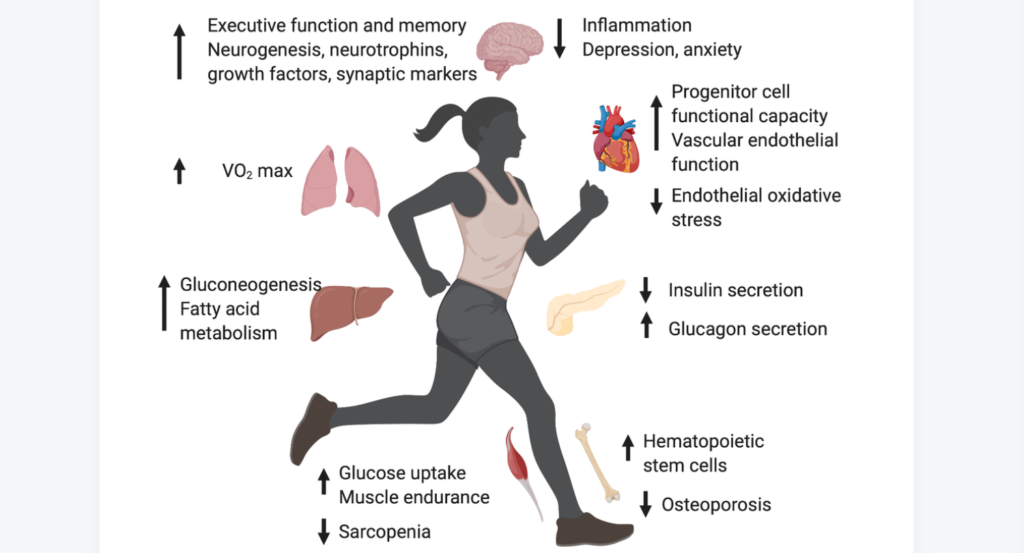The Trending with Impact series highlights Aging publications that attract higher visibility among readers around the world online, in the news, and on social media—beyond normal readership levels. Look for future science news about the latest trending publications here, and at Aging-US.com.
—
Regular physical exercise provides benefits for both the body and mind, but how exactly does this healthy habit benefit our cells, signaling pathways, organs, and even bones? Furthermore, how can we employ regular exercise as part of an anti-aging strategy to extend our healthspan and lifespan?
Two researchers from the Beta Cell Aging Lab at Harvard Medical School authored a recent review paper which breaks down the currently available research on this very topic, with a special focus on the effects of exercise in pancreatic beta-cells and Type 2 diabetes. The authors detailed the known effects of exercise at systemic and cellular levels, its effects on each of the hallmarks of aging, and a potential molecular regulatory node that may integrate those effects. This review was published in May of 2021 by Aging, and entitled: “Effects of exercise on cellular and tissue aging.”
The Nine Hallmarks of Aging
With age, cellular functions and systems in the human body progressively decline and destabilize, which eventually leads to disease and all-cause mortality. There are nine hallmarks of aging, which are classified as either primary, secondary, or integrative: genomic instability, telomere attrition, epigenetic alterations, loss of proteostasis, deregulated nutrient-sensing, mitochondrial dysfunction, cellular senescence, stem cell exhaustion, and altered intercellular communication.
“Exercise is a promising lifestyle intervention that has shown antiaging effects by extending lifespan and healthspan through decreasing the nine hallmarks of aging and age-associated inflammation.”
The researchers in this review explain that exercise is capable of counteracting each of the nine hallmarks of aging at systematic and cellular levels. They used publicly available research to cite and discuss the effects of exercise in each hallmark of aging in clear and thorough detail. The purpose of this article is to summarize this review, though readers are highly encouraged to read the full paper for deeper insights.
“The literature was surveyed on MEDLINE through freely accessible PubMed as a search engine for the terms: ‘exercise’, ‘longevity’ and ‘aging’; the most relevant studies were included as they related to the 9 hallmarks of aging.”
AMPK as a Central Regulator
“In summary, exercise attenuates all hallmarks of aging through different molecular pathways and effectors that seem independent and disconnected.”
Given that exercise regulates each of these hallmarks individually, the researchers hypothesize that there must exist some kind of molecular regulatory node(s) capable of coordinating these responses. They propose that the 5’ adenosine monophosphate-activated protein kinase (AMPK) enzyme/protein could play this role.
“In summary, AMPK activation through exercise can impact all the hallmarks of aging through different signaling pathways as summarized in Figure 2 and can act as a signaling node capable of orchestrating many of the effects of exercise on the health span of different tissues and organs.”
Exercise and Type 2 Diabetes
The researchers also discuss the effects of exercise on Type 2 diabetes mellitus (T2D).
“In summary, exercise activates molecular signals that can bypass defects in insulin signaling in skeletal muscle and increase skeletal muscle mitochondria, which are associated with improved insulin sensitivity in skeletal muscle and therefore improve aging-associated effects of T2D.”

Conclusion
“We propose that future studies should address the effects of exercise on tissues which are not considered its direct targets but do show accelerated aging in T2D, such as pancreatic β-cells. In these, the role of AMPK and its physiological control will become especially significant as exercise is considered a cellular antiaging strategy.”
Click here to read the full review, published by Aging.
—
Aging is an open-access journal that publishes research papers monthly in all fields of aging research and other topics. These papers are available to read at no cost to readers on Aging-us.com. Open-access journals offer information that has the potential to benefit our societies from the inside out and may be shared with friends, neighbors, colleagues, and other researchers, far and wide.
For media inquiries, please contact [email protected].

